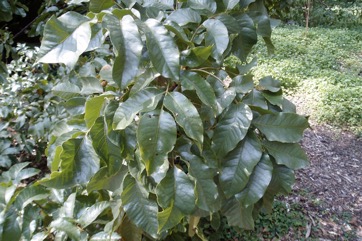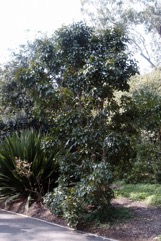Burdekin plum, Tulip plum

A tropical plant. It is native to Malesia and Australia. It grows in open forest and coastal scrub. It suits tropical, subtropical and warm temperate regions. It needs well drained soil and a sunny position. It can tolerate light frost. It can tolerate slightly salty conditions. In Wittunga Botanical Gardens Adelaide.
Also known as:
Injo wato, Lumba, Pohon injo, Pohon lumba, Pohon wato, Woigiek
Synonyms
- Clausena timorensis M. Roem.
- Icica timoriensis A. DC.
- Owenia cerasifera F. Muell.
- Pleiogynium cerasiferum (F.Muell.) R.Parker
- Pleiogynium cerasiferum var. glabratum Domin
- Pleiogynium solandri (Benth.) Engl.
- Spondias pleiogyna F. Muell.
- Spondias solandri Benth.
- Pleiogynium papuanum
Edible Portion
- Fruit, Seeds
Where does Burdekin plum grow?
Found in: Africa, Asia, Australia, Cook Is., East Timor, Fiji, India, Indonesia, Malaysia, New Caledonia, North America, Pacific, Papua New Guinea, PNG, Philippines, Rotuma, SE Asia, Solomon Islands, Timor-Leste, Tonga, United States
Notes: There are 1 or 2 Pleiogynium species.
Growing Burdekin plum, Tulip plum
Cultivation: Plants are grown from fresh seed. The seeds germinate erratically. It is best to scratch the hard seed coat then soak them in warm water for 24 hours. They can also be grown by cuttings and layering.
Edible Uses: The ripe fruit are edible. The flesh of the fruit is used to make jam. The seeds are edible.
Production: Seedling trees take 7 years to produce fruit. Trees can produce large crops. Fruit are usually gathered after they have fallen from the tree. The fruit need to be softened in paper bags in the dark, or by burying for several days.
Nutrition Info
per 100g edible portion| Edible Part | Energy (kcal) | Protein (g) | Iron (mg) | Vitamin A (ug) | Vitamin c (mg) | Zinc (mg) | % Water |
|---|---|---|---|---|---|---|---|
| - | - | - | - | - | - |
Burdekin plum, Tulip plum Photos


References
Ambasta, S.P. (Ed.), 2000, The Useful Plants of India. CSIR India. p 469
Anon., 2003, Native Plants for the Fitzroy basin. Society for Growing Australian Plants Inc. (Rockhampton Branch) p 72
Barwick, M., 2004, Tropical and Subtropical Trees. A Worldwide Encyclopedic Guide. Thames and Hudson p 330
Beasley, J., 2011, Plants of Tropical North Queensland - the compact guide. Footloose publications. p 59
Blumea 7:159. 1952
Bodkin, F., 1991, Encyclopedia Botanica. Cornstalk publishing, p 812
Calvert, G., 2010, The Burdekin Delta Tree Guide. Lower Burdekin Landcare Association., Inc., Ayr p 143
Cherikoff V. & Isaacs, J., The Bush Food Handbook. How to gather, grow, process and cook Australian Wild Foods. Ti Tree Press, Australia p 33, 201
Cooper W & Cooper W T, 1994, Fruits of the Rain Forest. RD Press p 226
Cooper, W. and Cooper, W., 2004, Fruits of the Australian Tropical Rainforest. Nokomis Editions, Victoria, Australia. p 17
Cowie, I, 2006, A Survey of Flora and vegetation of the proposed Jaco-Tutuala-Lore National Park. Timor-Lests (East Timor) www.territorystories.nt/gov.au p 42
Cribb, A.B. & J.W., 1976, Wild Food in Australia, Fontana. p 51
Doran, J.C., & Turnbull, J.W. (Eds), 1997, Australian Trees and Shrubs: species for land rehabilitation and farm plantings in the tropics. ACIAR Monograph No 24. p 357
Elliot, W.R., & Jones, D.L., 1997, Encyclopedia of Australian Plants suitable for cultivation. Vol 7. Lothian. p 382 (Photo)
Facciola, S., 1998, Cornucopia 2: a Source Book of Edible Plants. Kampong Publications, p 10 (As Pleiogynium solandri)
Franklin, J., Keppel, G., & Whistler, W., 2008, The vegetation and flora of Lakeba, Nayau and Aiwa Islands, Central Lau Group, Fiji. Micronesica 40(1/2): 169–225, 2008
Hibbert, M., 2002, The Aussie Plant Finder 2002, Florilegium. p 236
Hiddins, L., 1999, Explore Wild Australia with the Bush Tucker Man. Penguin Books/ABC Books. p 130
Isaacs, J., 1987, Bush Food, Aboriginal Food and Herbal Medicine. Weldons. p 69
Jackes, B.R., 2001, Plants of the Tropics. Rainforest to Heath. An Identification Guide. James Cook University. p 39
Jones D, L, 1986, Ornamental Rainforest Plants in Australia, Reed Books, p 238, 340
Kiple, K.F. & Ornelas, K.C., (eds), 2000, The Cambridge World History of Food. CUP p 1740
Lord, E.E., & Willis, J.H., 1999, Shrubs and Trees for Australian gardens. Lothian. p 20
Low, T., 1991, Wild Food Plants of Australia. Australian Nature FieldGuide, Angus & Robertson. p 89
Low, T., 1992, Bush Tucker. Australia’s Wild Food Harvest. Angus & Robertson. p 61
Lyle, S., 2006, Discovering fruit and nuts. Land Links. p 331
Martin, F. W., et al, 1987, Perennial Edible Fruits of the Tropics. USDA Handbook 642 p 14 (As Pleiogonium solandri)
Melzer, R., & Plumb, J., 2011, Plants of Capricornia. Belgamba, Rockhampton. p 66
Menninger, E.A., 1977, Edible Nuts of the World. Horticultural Books. Florida p 53
Nicholson, N & H., 1996, Australian Rainforest Plants 2, Terania Rainforest Publishing. NSW. p 50
Pearson, S. & A., 1992, Rainforest Plants of Eastern Australia. Kangaroo Press p 168
Queensland Forest Service, 1991, Trees and Shrubs. Department of Primary Industries. p 112
Recher, P, 2001, Fruit Spirit Botanical Gardens Plant Index. www.nrg.com.au/~recher/ seedlist.html p 3
Smith, K & I., 199, Grow your own bushfoods. New Holland. Australia. p 27
Sukarya, D. G., (Ed.) 2013, 3,500 Plant Species of the Botanic Gardens of Indonesia. LIPI p 459
Thaman, R.R., 1976, The Tongan Agricultural System, University of the South Pacific, Suva, Fiji. p 418 (As Pleiogynium solandri)
Townsend, K., 1994, Across the Top. Gardening with Australian Plants in the tropics. Society for Growing Australian Plants, Townsville Branch Inc. p 318
Townsend, K., 1999, Field Guide to Plants of the Dry Tropics. Society for Growing Australian Plants, Townsville Branch Inc. p 79
Walter, A. & Sam C., 2002, Fruits of Oceania. ACIAR Monograph No. 85. Canberra. p 281
Wickens, G.E., 1995, Edible Nuts. FAO Non-wood forest products. FAO, Rome. p 107
Williams, J.B., Harden, G.J., and McDonald, W.J.F., 1984, Trees and shrubs in rainforests of New South Wales and Southern Queensland. Univ. of New England, Armidale. p 36
World Checklist of Useful Plant Species 2020. Royal Botanic Gardens, Kew
Yuncker, T.G., 1959, Plants of Tonga, Bernice P. Bishop Museum, Hawaii, Bulletin 220. p 171 (As Pleiogynium solandri)